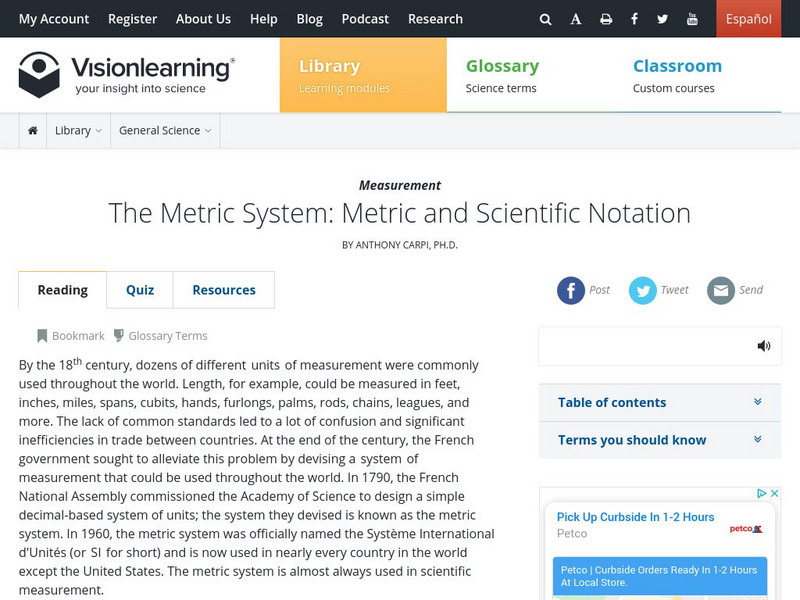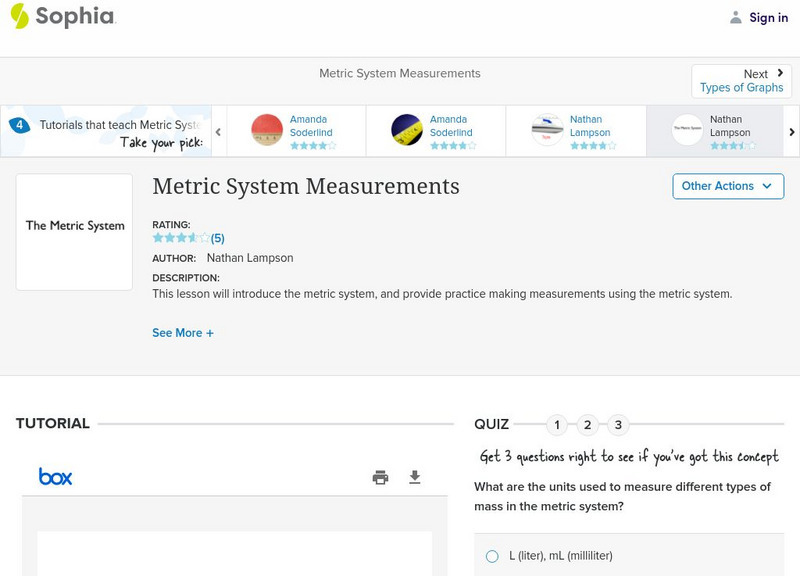Hi, what do you want to do?
Curated OER
Looking into Eratosthenes' Radius of the Earth
Students, in small groups, research Eratosthenes and his calculations of the Earth's radius. They write a summary of the person, the experiments and his calculations to determine how accurate Eratosthenes was in his estimations of the...
Curated OER
Which Way to Roots Grow?
Second graders explore roots and how they grow. They observe as seeds planted in various directions grow and record their observations. Students discuss the direction in which the roots are growing.
Curated OER
Math and Science in a Wetland
Learners describe safe practice when doing field and lab investigations in a estuary or wetland. They create a model of an estuary and describe their value and function. They participate in field study in which they collect and analyze...
Curated OER
A thousand seconds
Students use seconds, minutes, and hours. They then discuss the size of a thousand. After that they read time in digital or analogue form.
Curated OER
Garry The Greengrocer
Fourth graders are introduced to the problem by weighing objects on the balance scales. Use weights in both pans. (If you don't have access to scales use 2 containers and a child acting as the balance.) They then listen to the problem...
Curated OER
Decimals Vocabulary Matching
In this decimal vocabulary learning exercise, students match a set of 27 words to their correct definitions. Answers are included on page 2; a reference web site is given for additional activities.
Curated OER
Egyptian Weather Lesson
Learners chart temperatures in Egypt on spreadsheet to determine how weather conditions affect lifestyles.
Curated OER
Squid Races
Students imitate squid propulsion using a balloon and experience Newton's third law: for every action there is an equal and opposite reaction. Various anatomical designs are tested and analyzed. They calculate the speed of each squid...
Curated OER
Sun and Temperatures
Students consider the relationship of temperature to environmental conditions and then apply their knowledge to a practical event. The task assesses students' knowledge and application of that knowledge to an additional situation.
Curated OER
Our Favorites
Students participate in and conduct a survey to determine various class favorites. They collect, organize and display their data, interpret the results, and complete a packet of worksheets to display the information.
Curated OER
Explain Plant Chemical Processes
Students discover plant chemical processes through three lab activities. Overheads, data sheets, and teaching procedures provided for the unit covering photosynthesis, respiration, and transpiration.
Curated OER
Newton's Laws and Winter Sports
Learners investigate past winter Olympic games utilizing any skiing or snowboarding event to take Newton's Challenge. Helpful Web resources are provided and students enjoy learning science laws along with researching Olympic events.
Curated OER
Crop Circles
Learners calculate the area and circumference of a circle. In this geometry lesson, students solve word problems with circles and create formulas to calculate the area. They find the rate and complex area of a circle.
Curated OER
A CEENic Galaxy Quest!
Students research the distances between objects in the Milky Way. In this astronomy instructional activity, students calculate the time it would take for a robot to travel from Milky Way object to another. They create a travel package...
Curated OER
Air and Water in the Environment
Second graders participate in a three part lesson in which they identify and describe forms of moisture in the environment. Part one of the lesson involves the three stages of the water cycle, part two focuses on creating humidity by...
Curated OER
Why Are Cells So Small?
Students examine the relationship between cell surface area and the ability of materials to diffuse through a cell. They participate in an experiment in which they determine which materials diffuse easier than others. They complete...
Curated OER
Insects and Spiders
Students make either and insect or a spider using materials their teacher provides. They then draw of picture of their organism and defend why it is either a spider or an insect.
Curated OER
Chuukese Dinner (high School)
Young scholars read journal entries about having dinner with a Chuukese family. Using this information, they identify which foods sound appealing and compare and contrast Micronesian and American foods, fruits and vegetables. In...
Curated OER
Deer Tracks
Students use satellite images to track to movement patterns of deer and examine deer behavior. They write stories about a day in the life of a field scientist.
Curated OER
Two Ways About It
Students take an imaginary hike in two opposite directions along a lake. They view and interpret satellite images and discuss the pros and cons of hydroelectric dams.
Vision Learning
Visionlearning: General Science: Metric System: Metric and Scientific Notation
Instructional module focusing on the metric system. Discussion includes the historical development of the system and an explanation of base units. Site also includes an interactive practice quiz and links relating to the topic.
Cuemath
Cuemath: Metric System
Learn more about the metric system by taking a look at the common metric units along with some solved examples and a few practice questions to test your understanding.
Sophia Learning
Sophia: Metric System Measurements
A guided lesson introducing the metric measuring system and providing practice with some of the units.
McGraw Hill
Glencoe: Self Check Quizzes 1 Changing Metric Units
Use Glencoe's randomly generated self-checking quiz to test your knowledge of converting within the Metric System. Each question has a "Hint" link to help. Choose the correct answer for each problem. At the bottom of the page click the...




























